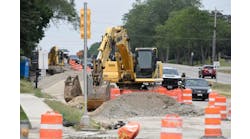Roadbuilding is not only done in the public sector. For example, there are large properties that have been subdivided where extensive road systems must be built prior to the site prep work that is carried out for new homebuilding projects. Depending on the location, the interior of the subdivision might be inaccessible even with the likes of four-wheel-drive vehicles. So are the typical roadbuilding sites that Hubbell Inc. is currently undertaking.
Hubbell Inc. is one of the Hubbell Cos. Group of Margaretville, N.Y. Under the same umbrella also are Hubbell Logging & Land-Clearing, Empire Links LLC and Catskill Rental. From the start in 1848, the Hubbell companies have been family owned, beginning as enterprises in farming, hardware, lumber, feed and a machine shop.
The company was founded by brothers Burr and John Hubbell. The current company president is Rudd Hubbell. Rudd oversees Hubbell Inc., a company that is a site development and excavation contractor serving southeastern New York and northeastern Pennsylvania. This area includes the New York Catskill Mountain Region, which links to the Pocono Mountains of Pennsylvania.
Currently, the company is involved in major roadbuilding projects in the Poconos area close by Wilkes-Barre and Scranton and only 1½ hours north by car from Philadelphia. Among others, the subdivisions will attract people who can easily commute to the cities of Hazelton, Scranton and Wilkes-Barre. Much of the undeveloped Poconos area is covered with well-established hardwood trees and gentle flattop mountains reaching 1,400 to 1,800 ft in elevation. Hard sandstone is found throughout the Poconos area, and one 485-acre homebuilding site where Hubbell is currently building a main road is no exception. It is designated the Goodleigh Manor Residential Subdivision. The owner is Landview Properties LLC of Dallas, Pa.
The subdivision is in Dallas Township and each homebuilding property ranges from a generous 2 to 15 acres. The complete area is a forest of hardwoods such as birches and oaks. An additional attribute attractive to potential homeowners is the rolling hills that lend themselves to making very attractive home settings.
The road now under construction is 25,000 ft long with a 54-ft-wide right-of-way. It features two 11-ft-wide lanes with 5-ft shoulders on either side of the roadway. To make the road gentler than some of the steep hills encountered, 700,000 cu yd of rock must be drilled and shot for making cuts up to 57 ft, with most cuts ranging from 25 to 35 ft deep. Fills are being made with 300,000 cu yd of the excavated rock by crushing it using two portable Pegson primary and secondary crushers. Another 150,000 cu yd of the crushed rock will be used by the contractor for base material at 50 of the 141 home sites’ driveways. Lastly, 50,000 cu yd of PennDOT Modified 2a stone will be used for sections of the road’s sub-base.
In the end, Hubbell will have made numerous cuts and fills on the 5-mile main road and likewise on 2.5 miles of home driveways. A second project owned by the same developer is Blue Heron Woods, located two miles from the well-known recreational body of water, Lake Wallenpaulpack. There will be 150 properties available for building homes on the 600-acre tract. This project calls for a 3-mile road to be built. Additionally, another development near Moscow will call for a 5-mile road, and in Sullivan County, N.Y., there is a 1.5-mile road to be built in addition to an earthen-concrete dam.
A private matter
Rudd Hubbell recognizes he must be a good businessman first if he wants his company to continue building roads owned by the private sector. Unlike dealing with the government, where business is only as good as the next winning bid, business-to-business success is contingent on developing sound relationships with the customers by earning their trust and confidence in the company. Only 20% of the company’s business is derived from the public sector, which is mostly municipalities and New York State DOT work that is within a 40-mile radius of Hubbell’s corporate headquarters.
When he took charge of the company, there were six employees. Now the company employs 50 people or more, many of them heavy-equipment operators needed to carry out the road- and site-work projects. The company owns 30 major pieces of equipment, which are central to carrying out the business.
With extensive excavation required at all of Hubbell’s projects, excavators are much needed because of encountering heavy rock excavation. Pull-pans, or scrapers, are out of the question, so excavators and articulated trucks are used for doing the major share of the excavation, followed by bulldozers, which are used for profiling and rough grading of the landscape. Most of the fine grading of new roads is carried out using a motor grader.
Good business to Rudd means getting continued work from private companies, such as Landview Properties. Performing high-quality work for such companies makes the projects less price-sensitive. The key, however, is quality work completed on schedule. Both require not only good operators, but also good-quality, high-performing equipment. To that end, Hubbell’s preference is for excavators backed by a strong dealer network. That strategy is combined with very good operators for high performance.
“Rarely an excavator goes down, but when it does and we cannot fix it there is a mechanic on the site [from the dealer] within 24 hours,” said Rudd. “If it were needed, the dealer will bring another excavator to the site while the other is being fixed. This arrangement has given us the assurance we need to help ensure our customer the project will be completed on schedule.”
There are five Link-Belt excavators operating on the Goodleigh Manor project: two model 460 LXs, a 330 LX, a 210 LX and a 130 LX. All excavators are fitted with quick couplers for the quick changing of different attachments. One 460 LX has more than 5,000 machine hours on it while the other has 4,500 hours. One is used for making major cuts in the road following the drilling and blasting of rock by others. Using 30-ton-capacity Terex articulated trucks for hauling, the 460 LX can load one in four passes with a 4.8-cu-yd struck (5.5-cu-yd heaped) bucket. Production has been very good, with the excavator loading 20 30-ton-capacity (23-cu-yd) trucks in an hour.
Bill Johnson, project manager for Hubbell, said the productivity has been outstanding. “So far we have used the 460 LX for excavating 98% of all major rock excavation sites on this project with good productivity and machine reliability,” he said.
The other 460 LX is currently being used to feed the jaw crusher for reducing the rock size. From the jaw crusher plant, the crushed rock is conveyed to an impactor portable plant making 3-in. minus and PennDOT 2a crushed stone. At the secondary, it is operated in a closed circuit with a screen for ensuring no oversized rock.
The 3-in. minus stone is used as base material for the home driveways. Nearly 53,000 tons of rock is being crushed. For meeting the crusher’s 3-in. minus production capacity, the excavator feeds the jaw crusher at a 200 tons per hour (tph) throughput rate.
For making the PennDOT 2a size, 27,000 tons of rock is being crushed and screened. Crushing the rock to this smaller size reduces the throughput rate to 160 tph at the impactor.
“The [excavator] has been plenty productive for the crushing-screening operation. It can feed the system, keeping it operating optimally,” said Johnson.
Using a stacker, the finished material is stacked for immediate loading onto the articulated trucks with a John Deere 5-cu-yd-capacity wheel loader.
There is much more work for Hubbell than just building the roads on these projects. One job is the installation of the storm-water main. At one side of the road’s alignment, the Link-Belt 330 LX is used for doing all the trenching needed to install 16,000 lineal ft of storm-water pipe and 108 precast concrete 4- to 4½-ton manhole structures. Digging depths range from 12 to 16 ft deep. Most of the digging was rock that had to be drilled and blasted. To ensure safety for the laborers working in the trench, the trench was cut with step-backs in the walls instead of using a trench box or making slopes.
For installing the main electric underground wire, a trench is made along the road alignment 36 in. wide and 42 in. deep. Lastly, a small excavator is used for shaping the swales and grading the shoulders by using a 60-in.-wide grading bucket.
Cold reception
An important attribute of the excavators has been their reliability during the winter months.
“We have been using the excavators in -15° [Fahrenheit] weather with no operation problems experienced. Their performance in such cold weather enabled us to continue operating during the winter months both in New York and Pennsylvania,” said Rudd.
Pointing out the machine hours on the different excavators puts each in an operating life classification that is made up by Hubbell. The excavator classification helps the company utilize each piece based on optimizing it more cost-effectively. All excavators in the company fleet are classified as A-line or B-line, depending on the machine hours spent. A-line excavators have 1 to 10,000 machine hours. Rudd said these excavators are in their prime of reliability and thus can be operated for 50 to 60 hours a week without incident. “There is little to no unscheduled downtime on these excavators so the work on the project work is not held up. If an excavator goes down, it is more than an operator and machine that is held up. It is at least the whole crew, including trucks and drivers,” he said.
B-line excavators have 10,000 to 15,000 hours on them. They are used to carry out work on projects where, if they break down, they will not substantially hinder the workflow on the project. Rudd said the B-line excavators still show 95% availability.
“We usually use them on projects where they are needed about 20 hours a week. They still are good machines and it is cost-effective to use them because they have already been depreciated,” said Rudd.
Once past 15,000 hours, Rudd evaluates the equipment individually to decide whether it is time to trade it in for a new one or not.
Other roadbuilding and site-preparation contractors might want to consider building new roads for land developers. Paving expertise is not important, as Hubbell leaves that to the others.
Not as many contractors cater to this kind of business because it cannot be gained by simply putting in the low bid, such as what is done for public-sector work. However, Rudd pointed out that consistently doing high-quality work on time and giving the owner value-added services are absolute musts. That said, the work can be attractively profitable, and many customers represent repeat business.


